schoolchildren
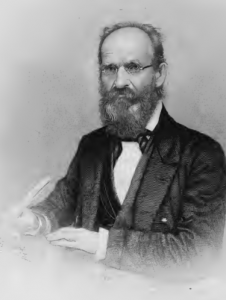 Platt Rogers Spencer, who is my 3rd cousin 5 times removed, was a social activist. In other words, he saw something that was socially or morally wrong, such as slavery, and he actively fought against it. These days that would mean protesting, lobbying, and blogging against it. Social activism has it’s place, but should be done in the proper way. Platt Spencer was a zealous promoter of the antislavery movement…an honorable cause. He was a prominent advocate of the abstinence movements. He was instrumental in founding business colleges in the United States, and was in organizing several business colleges in the United States, and he was an instructor in business colleges throughout the country.
Platt Rogers Spencer, who is my 3rd cousin 5 times removed, was a social activist. In other words, he saw something that was socially or morally wrong, such as slavery, and he actively fought against it. These days that would mean protesting, lobbying, and blogging against it. Social activism has it’s place, but should be done in the proper way. Platt Spencer was a zealous promoter of the antislavery movement…an honorable cause. He was a prominent advocate of the abstinence movements. He was instrumental in founding business colleges in the United States, and was in organizing several business colleges in the United States, and he was an instructor in business colleges throughout the country.
In 1815, Spencer taught his first writing class, and in New York, where he founded the Spencer Seminary in Jericho, housed in a log cabin. From 1816 to 1821, he was a clerk and a book keeper and, from 1821 to 1824, he studied in law, Latin, English literature and penmanship. He also taught in a common school and wrote up merchants’ books. 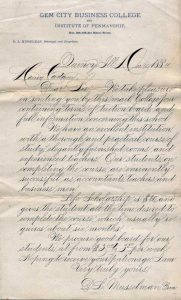 In 1824, he contemplated entering college with a view to preparing for the ministry, but, due to his alcoholism, which was aggravated by the prevalent drinking customs of the time, he did not. He struggled with alcoholism for a number of years. He then taught in Ohio, where in 1832, he was able to withdraw from alcohol completely, becoming a total abstainer. He advocated abstaining from alcohol for the remainder of his life. Soon after his recovery from alcoholism, he was elected to public office, as county treasurer of Ashtabula County, Ohio for twelve years. He also was a founding member of the Ashtabula County Historical Society established in 1838 and he was instrumental in collecting the early history of Ashtabula County, Ohio.
In 1824, he contemplated entering college with a view to preparing for the ministry, but, due to his alcoholism, which was aggravated by the prevalent drinking customs of the time, he did not. He struggled with alcoholism for a number of years. He then taught in Ohio, where in 1832, he was able to withdraw from alcohol completely, becoming a total abstainer. He advocated abstaining from alcohol for the remainder of his life. Soon after his recovery from alcoholism, he was elected to public office, as county treasurer of Ashtabula County, Ohio for twelve years. He also was a founding member of the Ashtabula County Historical Society established in 1838 and he was instrumental in collecting the early history of Ashtabula County, Ohio.
In 1840, Platt developed a beautiful and unique style of writing and named it after himself, calling it Spencerian Script. The penmanship style quickly became the standard in the United States from 1850 to 1925. It was considered the American de facto standard writing style for business correspondence prior to the widespread adoption of the typewriter. Platt used various existing styles as the inspiration for his unique oval-based style. His style could be written quickly and legibly and yet it still looked elegant, which made it perfect for business 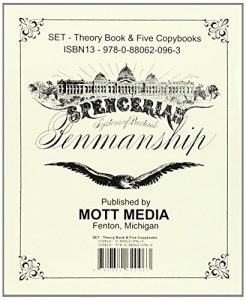 correspondence, as well as personal letters. Immediately following his development of the Spencerian Script style, Platt began teaching it in the schools he established for the purpose of teaching his penmanship style. As soon as his students began to graduate, they started replicas of the Spencerian Script abroad, and then in 1850 it reached the common schools. Unfortunately, Platt Spencer never got to see the full success of his unique penmanship, because he died on May 16, 1864. Nevertheless, his sons made it their mission to bring their late father’s dream to fruition. They accomplished that feat by distributing Spencer’s previously unpublished book, Spencerian Key to Practical Penmanship, in 1866. Spencerian Script was gradually replaced in primary schools with the simpler Palmer Method developed by Austin Norman Palmer…which is sadly very plain by comparison. The Coca-Cola Company famously used Spencerian Script in its now famous logo, and continues to do so to this day.
correspondence, as well as personal letters. Immediately following his development of the Spencerian Script style, Platt began teaching it in the schools he established for the purpose of teaching his penmanship style. As soon as his students began to graduate, they started replicas of the Spencerian Script abroad, and then in 1850 it reached the common schools. Unfortunately, Platt Spencer never got to see the full success of his unique penmanship, because he died on May 16, 1864. Nevertheless, his sons made it their mission to bring their late father’s dream to fruition. They accomplished that feat by distributing Spencer’s previously unpublished book, Spencerian Key to Practical Penmanship, in 1866. Spencerian Script was gradually replaced in primary schools with the simpler Palmer Method developed by Austin Norman Palmer…which is sadly very plain by comparison. The Coca-Cola Company famously used Spencerian Script in its now famous logo, and continues to do so to this day.
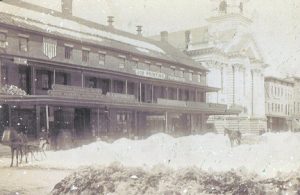 With all of the extreme weather shows, warnings, and education we have access to these days, one would think that blizzard related deaths would quickly become a thing of the past, but it never seems to go that way exactly. Nevertheless, it used to be much worse. In bygone years, the warnings we have today simply didn’t exist, and blizzards were very much feared by the people, and with good reason too. The storms would come up, seemingly without notice, and I suppose that was how it was. People couldn’t turn on their radio, television, computers, or smart phones, and get the weather forecast. They could look at the sky and feel the temperature changing, and maybe guess at what was coming, but if they were wrong, it could be deadly. Such was the case on January 12, 1888, when a blizzard blew into the Northwest Plains region of the United States with little or no warning. Some people said that the temperature dropped 100° in just 24 hours. A lot maybe, but I’ve seen temperature changes of more than 60°, so it’s possible.
With all of the extreme weather shows, warnings, and education we have access to these days, one would think that blizzard related deaths would quickly become a thing of the past, but it never seems to go that way exactly. Nevertheless, it used to be much worse. In bygone years, the warnings we have today simply didn’t exist, and blizzards were very much feared by the people, and with good reason too. The storms would come up, seemingly without notice, and I suppose that was how it was. People couldn’t turn on their radio, television, computers, or smart phones, and get the weather forecast. They could look at the sky and feel the temperature changing, and maybe guess at what was coming, but if they were wrong, it could be deadly. Such was the case on January 12, 1888, when a blizzard blew into the Northwest Plains region of the United States with little or no warning. Some people said that the temperature dropped 100° in just 24 hours. A lot maybe, but I’ve seen temperature changes of more than 60°, so it’s possible.
It was a Thursday afternoon and the weather had been unseasonably warm the previous day from Montana, east to the Dakotas, and south to Texas. Within a matter of hours, the Artic front blew in, plunging the temperature to 40° below zero in much of North Dakota. The freezing temperatures were joined by high winds and heavy snow. It was lethal combination that created a blinding blizzard, just when the children were on their 
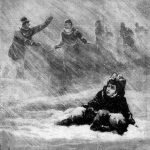
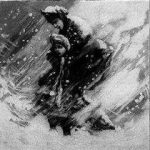 way home from school. The storm, coupled with the time of day, set the stage for a disaster, and unfortunately it would take the lives of 235 people…mostly children making their way home from school in rural areas and adults working on large farms. Both of these groups of people were taken by surprise, and were unable to find their way to their destinations.
way home from school. The storm, coupled with the time of day, set the stage for a disaster, and unfortunately it would take the lives of 235 people…mostly children making their way home from school in rural areas and adults working on large farms. Both of these groups of people were taken by surprise, and were unable to find their way to their destinations.
Some areas decided to err on the side of caution, and that resulted in lives saved. Schoolteacher, Seymour Dopp in Pawnee City, Nebraska, kept his 17 students at school when the storm began at 2 pm. They stayed overnight, burning stockpiled wood to keep warm. The next day, parents made their way over five foot snow drifts to rescue their children. I’m sure they were wondering if they would ever see their children again, because they couldn’t call to check on them, after all. Some areas ha drifts over ten feet too. In Great Plains, 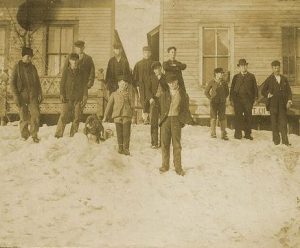 South Dakota, two men rescued the children in a schoolhouse by tying a rope from the school to the nearest shelter to lead them to safety. Minnie Freeman, a Nebraska teacher, successfully led her children to shelter after the storm tore the roof off of her one room schoolhouse. Sadly, not all efforts to save the children were successful. Teacher Loie Royce tried to lead three children to the safety of her home, which was less than 90 yards from their school in Plainfield, Nebraska. They all became lost. The children died of hypothermia, and Royce lost her feet to frostbite. The January 12th storm was dubbed the Schoolchildren’s Blizzard, because most of the 235 victims were children. It is considered one of the worst blizzards in the history of the area, to this day.
South Dakota, two men rescued the children in a schoolhouse by tying a rope from the school to the nearest shelter to lead them to safety. Minnie Freeman, a Nebraska teacher, successfully led her children to shelter after the storm tore the roof off of her one room schoolhouse. Sadly, not all efforts to save the children were successful. Teacher Loie Royce tried to lead three children to the safety of her home, which was less than 90 yards from their school in Plainfield, Nebraska. They all became lost. The children died of hypothermia, and Royce lost her feet to frostbite. The January 12th storm was dubbed the Schoolchildren’s Blizzard, because most of the 235 victims were children. It is considered one of the worst blizzards in the history of the area, to this day.

